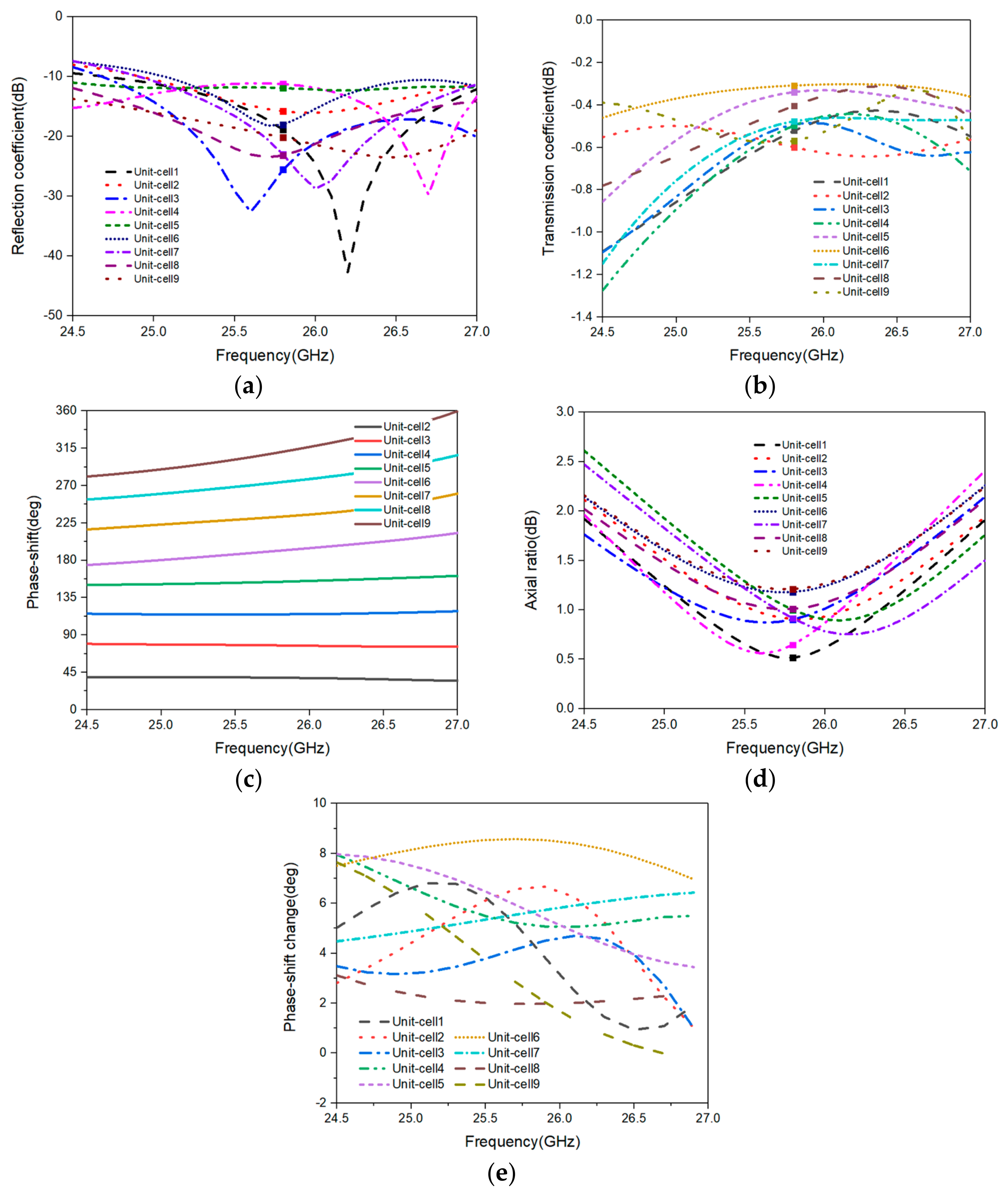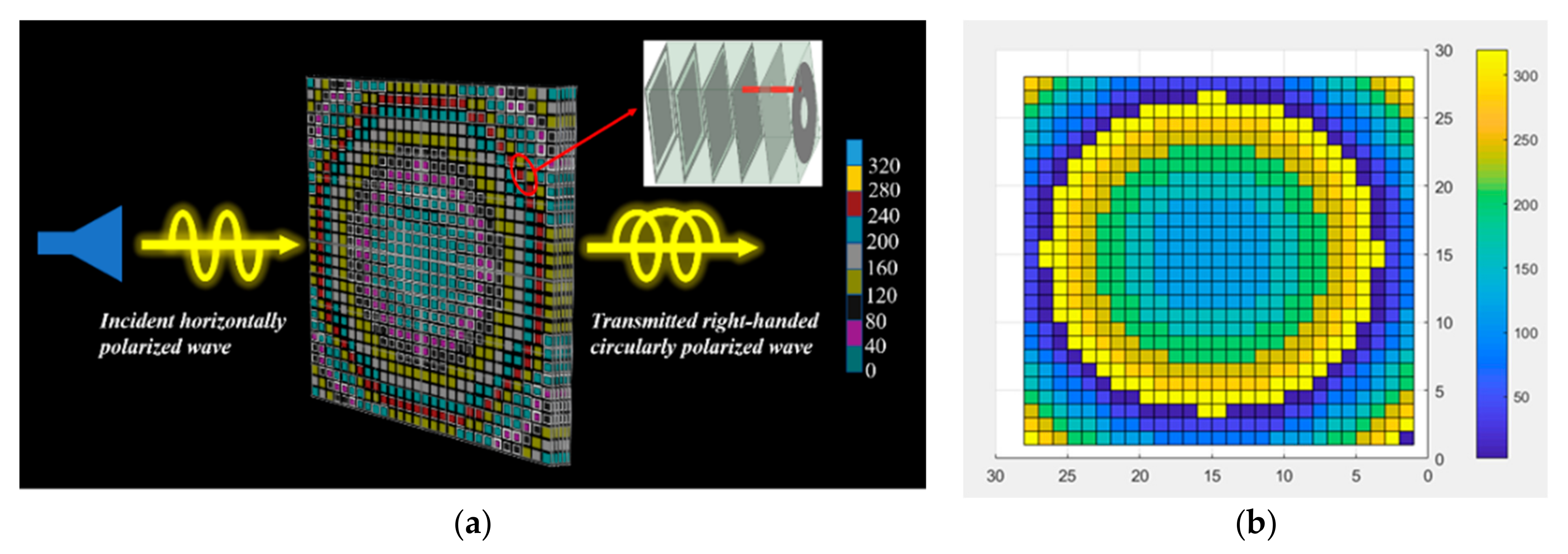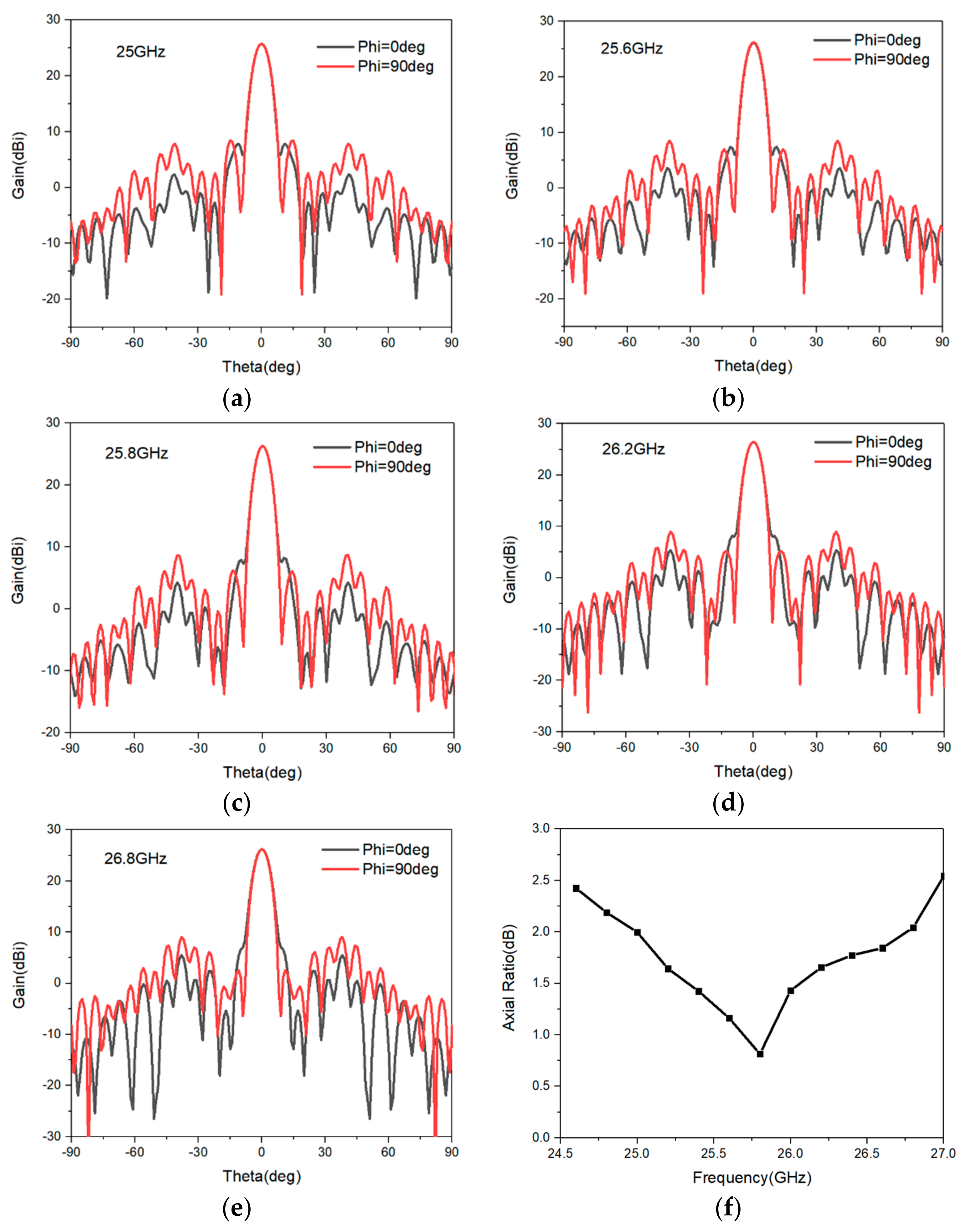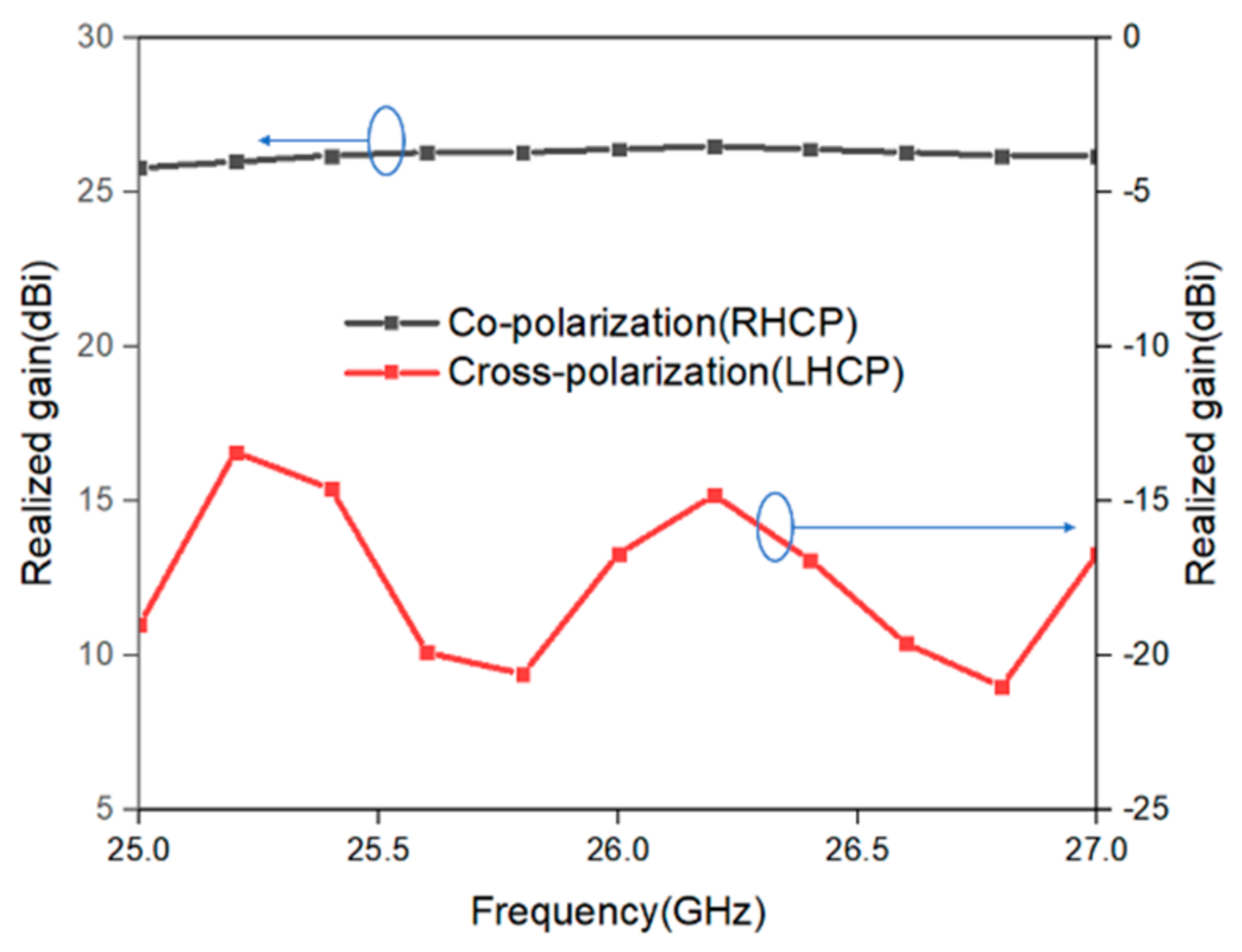A Subwavelength Transmit-Array Lens Element Combining Functions of Phase Modulation and Polarization Conversion
Abstract
:1. Introduction
2. Transmit-Array Element Structure
3. Array Verification Lens Element Function
4. Conclusions
Author Contributions
Funding
Institutional Review Board Statement
Informed Consent Statement
Conflicts of Interest
References
- Miao, Z.W.; Hao, C.H.; Luo, G.Q.; Gao, L. 140 GHz High-Gain LTCC-Integrated Transmit-Array Antenna Using a Wideband SIW Aperture-Coupling Phase Delay Structure. IEEE Trans. Antennas Propag. 2018, 66, 182–190. [Google Scholar] [CrossRef]
- Jazi, M.N.; Chaharmir, M.R.; Shaker, J.; Sebak, A.R. Broadband transmitarray antenna design using polarization-insensitive frequency selective surfaces. IEEE Trans. Antennas Propag. 2016, 64, 99–108. [Google Scholar] [CrossRef]
- Abdelrahman, A.H.; Elsherbeni, A.Z.; Yang, F. High-gain and broadband transmitarray antenna using triple-layer spiral dipole elements. IEEE Antennas Wireless Propag. Lett. 2014, 13, 1288–1291. [Google Scholar] [CrossRef]
- Rahmati, B.; Hassani, H.R. High-effificient wideband slot transmitarray antenna. IEEE Trans. Antennas Propag. 2015, 63, 5149–5155. [Google Scholar] [CrossRef]
- Erfani, E.; Niroo-Jazi, M.; Tatu, S. A high-gain broadband gradient refractive index metasurface lens antenna. IEEE Trans. Antennas Propag. 2016, 64, 1968–1973. [Google Scholar] [CrossRef]
- Wu, R.Y.; Li, Y.B.; Wu, W.; Shi, C.B.; Cui, T.J. High-gain dual-band transmitarray. IEEE Trans. Antennas Propag. 2017, 65, 3481–3488. [Google Scholar] [CrossRef]
- Pham, T.K.; Guang, L.; González-Ovejero, D.; Sauleau, R. Dual-Band Transmitarray With Low Scan Loss for Satcom Applications. IEEE Trans. Antennas Propag. 2021, 69, 1775–1780. [Google Scholar] [CrossRef]
- Zhang, H.; Bosma, S.; Neto, A.; Llombart, N. A Dual-Polarized 27 dBi Scanning Lens Phased Array Antenna for 5G Point-to-Point Communications. IEEE Trans. Antennas Propag. 2021, 69, 5640–5652. [Google Scholar] [CrossRef]
- Lima, E.B.; Matos, S.A.; Costa, J.R.; Fernandes, C.A.; Fonseca, N.J.G. Circular polarization wide-angle beam steering at Ka-band by in-plane translation of a plate lens antenna. IEEE Trans. Antennas Propag. 2015, 63, 5443–5455. [Google Scholar] [CrossRef]
- Diaby, F.; Clemente, A.; Pham, K.T.; Sauleau, R.; Dussopt, L. Circularly Polarized Transmitarray Antennas at Ka-Band. IEEE Antennas Wirel. Propag. Lett. 2018, 17, 1204–1208. [Google Scholar] [CrossRef]
- Matos, S.A.; Lima, E.B.; Silva, J.S.; Costa, J.R.; Fernandes, C.A. High gain dual-band beam-steering transmit array for satcom terminals at ka-band. IEEE Trans. Antennas Propag. 2017, 65, 3528–3539. [Google Scholar] [CrossRef]
- Di Palma, L.; Clemente, A.; Dussopt, L.; Sauleau, R.; Potier, P.; Pouliguen, P. Circularly-polarized reconfifigurable transmitarray in Ka-band with beam scanning and polarization switching capabilities. IEEE Trans. Antennas Propag. 2017, 65, 529–540. [Google Scholar] [CrossRef]
- Matos, S.A.; Lima, E.B.; Costa, J.R.; Fernandes, C.A.; Fonseca, N.J.G. Design of a 40 dBi planar bifocal lens for mechanical beam steering at ka-band. In Proceedings of the 2016 10th European Conference on Antennas and Propagation (EuCAP), Davos, Switzerland, 10–15 April 2016. [Google Scholar]
- Mao, C.; Gao, S.; Wang, Y. Broadband high-gain beam-scanning antenna array for millimeter-wave applications. IEEE Trans. Antennas Propag. 2017, 65, 4864–4868. [Google Scholar] [CrossRef]
- Mumcu, G.; Kacar, M.; Mendoza, J. Mm-wave beam steering antenna with reduced hardware complexity using lens antenna subarrays. IEEE Trans. Antennas Propag. 2018, 17, 1603–1607. [Google Scholar] [CrossRef]
- Xu, P.; Jiang, W.X.; Wang, S.Y.; Cui, T.J. An Ultrathin Cross-Polarization Converter With Near Unity Efficiency for Transmitted Waves. IEEE Trans. Antennas Propag. 2018, 66, 4370–4373. [Google Scholar] [CrossRef]
- Naseri, P.; Matos, S.A.; Costa, J.R.; Fernandes, C.A.; Fonseca, N.J.G. Dual-Band Dual-Linear-to-Circular Polarization Converter in Transmission Mode Application to K/Ka-Band Satellite Communications. IEEE Trans. Antennas Propag. 2018, 66, 7128–7137. [Google Scholar] [CrossRef] [Green Version]
- Wang, J.; Wu, W. Cavity-based linear-to-circular polarization converter. Opt. Express 2017, 25, 3805. [Google Scholar] [CrossRef]
- Li, L.; Li, Y.; Wu, Z.; Huo, F.; Zhang, Y.; Zhao, C. Novel Polarization-Reconfigurable Converter Based on Multilayer Frequency-Selective Surfaces. Proc. IEEE 2015, 103, 1057–1070. [Google Scholar] [CrossRef]
- Lin, B.; Wu, J.L.; Da, X.Y.; Li, W.; Ma, J.J. A linear-to-circular polarization converter based on a second-order band-pass frequency selective surface. Appl. Phys. A Solids Surf. 2017, 123, 43. [Google Scholar] [CrossRef]
- Xu, P.; Wang, S.-Y.; Geyi, W. A linear polarization converter with near unity effificiency in microwave regime. J. Appl. Phys. 2017, 121, 144502. [Google Scholar] [CrossRef]
- Abadi, S.M.A.M.H.; Behdad, N. Wideband linear-to-circular polarization converters based on miniaturized-element frequency selective surfaces. IEEE Trans. Antennas Propag. 2016, 64, 525–534. [Google Scholar] [CrossRef]
- Sohail, I.; Ranga, Y.; Esselle, K.P.; Hay, S.G. A linear to circular polarization converter based on Jerusalem-cross frequency selective surface. In Proceedings of the 2013 7th European Conference on Antennas and Propagation (EuCAP), Gothenburg, Sweden, 8–12 April 2013; pp. 2141–2143. [Google Scholar]
- Cao, Y.; Yang, W.; Xue, Q.; Che, W. A Broadband Low-Profile Transmitarray Antenna by Using Differentially Driven Transmission Polarizer With True-Time Delay. IEEE Trans. Antennas Propag. 2022, 70, 1529–1534. [Google Scholar] [CrossRef]
- Koutsos, O.; Manzillo, F.F.; Clemente, A.; Sauleau, R. Design of a 3-Bit Transmitarray Antenna at 300 GHz using Asymmetric Linear Polarizers. In Proceedings of the 2020 IEEE International Symposium on Antennas and Propagation and North American Radio Science Meeting, Montreal, QC, Canada, 5–10 July 2020; pp. 1505–1506. [Google Scholar]






| L1 | L2 | L3 | L4 | W1 | W2 | W3 | W4 | R_in | R_out | |
|---|---|---|---|---|---|---|---|---|---|---|
| Unit-cell1 | 2.58 | 2.34 | 2.3 | 2.92 | 0.1 | 0.18 | 0.1 | 0.13 | 0.4 | 1.69 |
| Unit-cell2 | 2.85 | 2.71 | 2.67 | 2.89 | 0.18 | 0.18 | 0.1 | 0.13 | 0.39 | 1.7 |
| Unit-cell3 | 2.56 | 2.7 | 3.11 | 3.09 | 0.18 | 0.19 | 0.14 | 0.12 | 0.39 | 1.69 |
| Unit-cell4 | 2.14 | 1.98 | 1.62 | 2.68 | 0.19 | 0.25 | 0.15 | 0.18 | 0.39 | 1.7 |
| Unit-cell5 | 3.12 | 3.16 | 3.08 | 3.1 | 0.13 | 0.11 | 0.08 | 0.14 | 0.39 | 1.71 |
| Unit-cell6 | 3.22 | 3.18 | 3.16 | 3.13 | 0.12 | 0.11 | 0.1 | 0.14 | 0.39 | 1.705 |
| Unit-cell7 | 2.18 | 2.11 | 1.5 | 2.25 | 0.35 | 0.1 | 0.15 | 0.1 | 0.4 | 1.7 |
| Unit-cell8 | 2.7 | 2.7 | 3.13 | 3.15 | 0.1 | 0.18 | 0.09 | 0.13 | 0.55 | 1.7 |
| Unit-cell9 | 2.33 | 2.2 | 1.1 | 2.9 | 0.17 | 0.25 | 0.15 | 0.18 | 0.39 | 1.7 |
| Ref. | Center Frequency (GHz) | Period of the Element (λ0) | Thickness of the Element (λ0) | Phase Modulation | Polarization Transformation | Measurement |
|---|---|---|---|---|---|---|
| [1] | 140 | 0.58 | 0.28 | 2 bit | × | √ |
| [3] | 12.25 | 0.6 | 0.5 | 3 bit | × | √ |
| [9] | 29.75 | 0.25 | 0.33 | 6 bit | × | √ |
| [10] | 29.5 | 0.5 | 0 | 3 bit | √ | √ |
| [11] | 25 | 0.29 | 0.81 | 3 bit | × | √ |
| [16] | 9 | 0.48 | 0.06 | × | √ | √ |
| [17] | 25 | 0.44 | 0.09 | × | √ | √ |
| [18] | 10 | 0.72 | 0.11 | × | √ | √ |
| [19] | 9.4 | 0.31 | 0.19 | × | √ | √ |
| [24] | 27 | 0.54 | 0.18 | 2 bit | √ | √ |
| [25] | 300 | 0.5 | 0.26 | 3 bit | √ | √ |
| This work | 25.8 | 0.31 | 0.32 | 3 bit | √ | × |
Publisher’s Note: MDPI stays neutral with regard to jurisdictional claims in published maps and institutional affiliations. |
© 2022 by the authors. Licensee MDPI, Basel, Switzerland. This article is an open access article distributed under the terms and conditions of the Creative Commons Attribution (CC BY) license (https://creativecommons.org/licenses/by/4.0/).
Share and Cite
Xu, T.; Lu, Y.; He, G.; Yang, X. A Subwavelength Transmit-Array Lens Element Combining Functions of Phase Modulation and Polarization Conversion. Appl. Sci. 2022, 12, 4745. https://doi.org/10.3390/app12094745
Xu T, Lu Y, He G, Yang X. A Subwavelength Transmit-Array Lens Element Combining Functions of Phase Modulation and Polarization Conversion. Applied Sciences. 2022; 12(9):4745. https://doi.org/10.3390/app12094745
Chicago/Turabian StyleXu, T., Y. Lu, G. He, and X. Yang. 2022. "A Subwavelength Transmit-Array Lens Element Combining Functions of Phase Modulation and Polarization Conversion" Applied Sciences 12, no. 9: 4745. https://doi.org/10.3390/app12094745
APA StyleXu, T., Lu, Y., He, G., & Yang, X. (2022). A Subwavelength Transmit-Array Lens Element Combining Functions of Phase Modulation and Polarization Conversion. Applied Sciences, 12(9), 4745. https://doi.org/10.3390/app12094745





